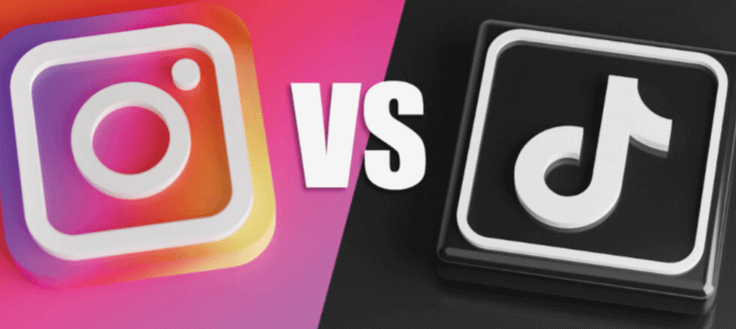Instagram vs. TikTok: Which Platform Is Best for Your Content?

In today’s rapidly evolving digital landscape, content creators and businesses are constantly seeking the best platforms to grow their audience, engage with followers, and increase brand visibility. Two platforms have come to dominate the social media space: Instagram and TikTok. Both offer distinct features, attract different audiences, and provide unique opportunities for content creation. But which one is better for you and your content? In this article, we’ll dive deep into the key differences between Instagram and TikTok to help you decide which platform suits your goals and strategy.
The Evolution of Instagram and TikTok
Instagram, launched in 2010, originally began as a photo-sharing app. Over time, it has evolved into a comprehensive multimedia platform, offering photos, videos, Stories, and Reels. It’s now part of the Meta (formerly Facebook) family, boasting over 1 billion active users globally. Instagram has become synonymous with highly curated content, from lifestyle posts to influencer campaigns and e-commerce integration.
TikTok, on the other hand, made its debut in 2016 under its original name, Douyin, in China. It went global as TikTok in 2018 after merging with the lip-syncing app, Musical.ly. Since then, it has skyrocketed in popularity, particularly among Gen Z, for its short-form, entertaining, and viral videos. TikTok’s focus is on quick, engaging, and often light-hearted content, with a heavy emphasis on music, trends, and viral challenges.
Audience Demographics: Instagram vs. TikTok
One of the most significant differences between Instagram and TikTok is their audience demographics. Instagram tends to have a broader and more diverse age range. While it still remains popular among younger users (millennials and Gen Z), it has seen significant adoption among older generations, particularly in the 25-44 age group. Instagram is a platform for people looking to follow both influencers and their friends, discover new brands, and engage with polished, high-quality content.
TikTok, by contrast, is more skewed towards younger users, especially Gen Z (ages 10-24). However, TikTok has been steadily expanding its user base, attracting older users as its popularity continues to surge. The platform’s algorithm is highly effective at delivering personalized content, making it incredibly engaging for users across all demographics.
For businesses or creators looking to target younger audiences or capitalize on viral content, TikTok might be the better option. On the other hand, if your brand caters to a broader audience or you focus on long-term brand building with diverse content formats, Instagram could be more suitable.
Content Formats: Which Platform Offers More Variety?
Instagram offers a wide array of content formats. You can post traditional photos, carousels, and videos to your feed. Instagram Stories allow you to share more fleeting, temporary content, while Instagram Live provides real-time engagement opportunities. Reels, Instagram’s answer to TikTok, enables users to create short-form videos similar to TikToks. Additionally, Instagram’s IGTV feature allows for long-form video content, giving users more flexibility when it comes to storytelling.
TikTok, in contrast, focuses almost exclusively on short-form video content, with its videos ranging from 15 seconds to 3 minutes in length. While this may seem limiting, it has led to a highly creative and innovative user base. TikTok offers a variety of video effects, filters, sounds, and editing tools, allowing creators to produce engaging and visually compelling content with ease.
If your content strategy involves showcasing a diverse range of media types, Instagram offers more versatility. However, if you’re focused primarily on short, entertaining videos that can go viral, TikTok’s simplicity and creativity-driven format may be more appealing.
Algorithm and Discoverability: How Do They Differ?
A crucial factor in choosing between Instagram and TikTok is how easily your content can be discovered by new audiences. TikTok’s algorithm is often cited as one of the most powerful tools for discoverability. The “For You” page on TikTok curates content tailored specifically to each user’s viewing habits. This means even creators with a small following can reach millions of viewers if their content resonates with the algorithm. TikTok rewards creativity and engagement, making it easier for content to go viral in a short amount of time.
Instagram’s discoverability, while still effective, operates a bit differently. Instagram’s Explore page is more personalized based on the accounts a user already follows and engages with. The introduction of Reels has somewhat leveled the playing field in terms of short-form content discoverability, but Instagram still prioritizes engagement within your existing follower base before pushing your content to new audiences.
If your goal is rapid growth and viral reach, TikTok’s algorithm offers a better chance of getting your content in front of new eyes. If you’re looking for steady, long-term growth with more control over how your audience engages with your content, Instagram might be a better fit.
Engagement: Which Platform Drives More Interaction?
Engagement is a critical metric for any content creator or business. On Instagram, engagement tends to be more personal and relationship-driven. Likes, comments, shares, and direct messages (DMs) all contribute to meaningful interaction between users and content. Instagram’s Story feature also plays a crucial role in keeping followers engaged through interactive stickers, polls, and Q&A sessions.
TikTok’s engagement is built around its participatory culture. Users interact with content not only by liking or commenting but also by creating their own videos in response to trends, challenges, or viral sounds. This form of “remix” culture fosters a highly interactive community, where users feel encouraged to join in and create their own spin on trending content. The platform’s duet and stitch features allow creators to collaborate in ways that feel more organic and dynamic.
For brands or creators focused on cultivating a deep relationship with their audience, Instagram’s emphasis on direct interaction might be more beneficial. However, if you’re looking to spark community participation and engage in trend-driven content, TikTok offers a more engaging platform.
Monetization: Where Can You Earn More?
Both Instagram and TikTok offer various monetization opportunities, but the approach is slightly different. On Instagram, creators can monetize their content through sponsored posts, affiliate marketing, and Instagram’s shopping feature, which allows users to purchase products directly from the app. Instagram also offers revenue through IGTV ads and Live badges (virtual tips during live streams).
TikTok offers several monetization options for creators as well, including brand partnerships, the TikTok Creator Fund, and in-app purchases through TikTok Coins. However, TikTok’s monetization model is still evolving, and while the Creator Fund allows users to earn from their content, payouts tend to be relatively modest unless you have a massive following.
For creators looking for a robust set of monetization tools, Instagram’s established ecosystem offers more diverse revenue streams. However, for those focused on viral growth and brand partnerships, TikTok’s creator-friendly environment can be equally lucrative.
Advertising Opportunities: Instagram vs. TikTok
When it comes to paid advertising, Instagram offers a more mature and integrated advertising platform. Through Instagram Ads, businesses can create highly targeted campaigns based on user behavior, demographics, and interests. Instagram Ads appear in the feed, Stories, Reels, and Explore page, providing multiple ways for brands to reach their target audience. Instagram’s close integration with Meta’s broader advertising platform also gives advertisers access to a wealth of data and insights, helping them refine their campaigns and maximize ROI.
TikTok Ads, while newer, have also proven to be highly effective, particularly for brands looking to tap into younger audiences. TikTok’s ad formats are designed to be immersive, including In-Feed Ads, Branded Hashtag Challenges, and Branded Effects. The platform’s full-screen video ads blend seamlessly into the user experience, making them less intrusive and more likely to engage users. TikTok’s native advertising tools are evolving rapidly, making it an increasingly viable option for advertisers.
For brands focused on sophisticated, data-driven advertising, Instagram’s established system may be more appealing. However, TikTok’s ad formats are more creative and engaging, especially for campaigns targeting younger audiences.
Content Aesthetic: Polished vs. Authentic
Instagram is known for its polished, curated content. Influencers and brands invest a great deal of time and effort in creating aesthetically pleasing photos and videos. Instagram has long been associated with perfection, with influencers presenting a highly edited version of their lives. This can be a double-edged sword, as some users find the platform too curated or inauthentic.
TikTok thrives on authenticity. The content is often raw, unfiltered, and relatable. TikTok’s emphasis on spontaneity allows creators to be themselves without the need for perfection. This has resonated particularly well with Gen Z, who value authenticity and transparency in the brands and influencers they follow.
If your brand leans towards high-quality, polished visuals, Instagram may be the better platform for you. On the other hand, if you prioritize authenticity and relatability in your content, TikTok’s approach will likely be more effective.
Conclusion: Instagram vs. TikTok – Which Is Best for Your Content?
Ultimately, the choice between Instagram and TikTok depends on your content strategy, target audience, and long-term goals. Instagram offers a more established platform with a wide range of content formats and monetization opportunities, making it ideal for businesses and creators focused on diverse content and long-term growth. TikTok, on the other hand, is perfect for those looking to capitalize on trends, go viral, and engage younger audiences with fun, authentic content.





